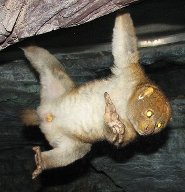 Potto (Perodicticus potto) is the name given to a family of strepsirrhine (wet, curly nostrils) primates known as Lorisidae. In some English-speaking parts of Africa, it is known as Softly-softly for the way it moves without making a sound. It is a relatively small animal, weighing in at about 3 pounds/1.5 kg and reaching an average length of 12-14 inches or 30-40 cm. It has a relatively small head in comparison to the rest of its body, suggesting a lesser intelligence.
Potto (Perodicticus potto) is the name given to a family of strepsirrhine (wet, curly nostrils) primates known as Lorisidae. In some English-speaking parts of Africa, it is known as Softly-softly for the way it moves without making a sound. It is a relatively small animal, weighing in at about 3 pounds/1.5 kg and reaching an average length of 12-14 inches or 30-40 cm. It has a relatively small head in comparison to the rest of its body, suggesting a lesser intelligence.There are several unique features to this animal’s anatomy. Three of the vertebrae in their neck have sharp points that almost pierce the skin and are used as a defense. If confronted, the potto will turn and hide its face and neck-butt the opponent. They do bite on occasion. The saliva of a potto has inflammatory properties, causing swelling at the site of the bite. Another notable feature is the opposable thumbs which help them to firmly grasp the branches of a tree. The index finger is considered to be a primitive feature that no longer serves a purpose. Pottos move slowly and quietly, always using at least 2 limbs to grasp a branch.
Pottos are nocturnal animals, moving around at night and sleeping in the leaves during the day. They typically live in the rainforests in tropical parts of Africa, very high up in the trees.
These primates emit an odor not unlike the smell of curry from their scent glands located underneath the tail. The courting ritual is a mutual grooming session while hanging upside down. They lick and comb each other’s fur with their claws and teeth, marking each other with their scent glands. Mating is face to face and upside down. Once impregnated, the gestational period lasts for approximately 170 days, producing only a single offspring. A baby potto is not fully mature until 18 months of age.
The potto is Class B of the African Convention which only allows it to be hunted or captured with special authorization from the government. International trade is also strictly controlled. The only real threat to the pottos’ lifestyle is habitat loss stemming from aggressive logging and agriculture. They can live in any type of tree. But they can’t live anywhere without them.
Picture of the potto by Ltshears at the Cincinnati zoo, licensed under Creative Commons Attribution 3.0 Unported
Which zoos have them?
Artis (Netherlands)The Potto gibbon, potto is listed as Least Concern (LR/lc), lowest risk. Does not qualify for a more at risk category. Widespread and abundant taxa are included in this category, on the IUCN Red List of Threatened Species
Countries
Benin, Burundi, Cameroon, Central African Republic, Congo, Democratic Republic of the, Congo, Republic of the, Cote d'Ivoire, Equatorial Guinea, Gabon, Gambia, The, Ghana, Guinea, GuineaBissau, Kenya, Liberia, Nigeria, Rwanda, Senegal, Sierra Leone, Togo and UgandaSome facts about the
Potto
Adult weight : 1.225 kg (2.695 lbs)
Maximum longevity : 27 years
Female maturity :547 days
Male maturity : 547 days
Gestation : 170 days
Weaning : 118 days
Litter size : 1
Litters per year : 1
Interval between litters : 198 days
Weight at birth : 0.044 kg (0.0968 lbs)
Basal metabolic rate : 2 W
Body mass : 0.969 kg (2.1318 lbs)
Temperature : 35.85 °C (96.53 °F)

Custom Search